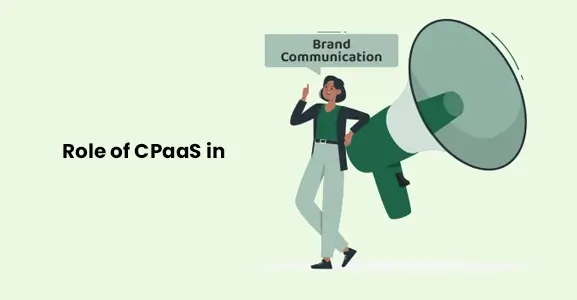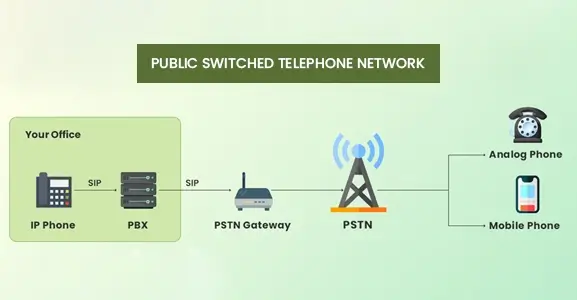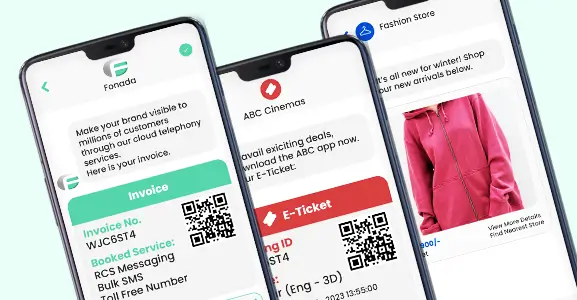The PSTN also known as Public Switched Telephone Network, is a system that allows folks to make calls through wired connections. Think of it as a vast network of cables and switches that link your phone to someone else’s when you dial a number. It’s the traditional method for making calls using landlines, distinct from cloud telephony solutions or cell phones.
This blog post dives deep into the PSTN network—explaining its functions and mechanics. If you want to enhance your understanding of the PSTN, this blog post is just what you need.
So, let’s dive in and explore!
What Is PSTN Network?
The PSTN, also known as the Plain Old Telephone Service (POTS), is a traditional network of connected phone systems using physical infrastructure like telephone poles and copper wires. Traditional systems rely on circuit switching to make calls globally. Despite today’s reliance on the internet and satellite communication, the PSTN in mobile communication remains rooted in using these physical connections.
While dependable, the PSTN has limitations. It’s reliable during power outages and doesn’t need the internet, but it lacks modern features like conference calls or call recording. Recently, there’s been a drop in demand for PSTN lines, especially in areas planning to switch to newer systems such as cloud phone systems & VoIP. Switching from PSTN to a digital phone system is significant.
While the PSTN has evolved, decreasing dependency on human operators and integrating with digital desk phones. These advancements fall short of meeting present communication demands. Voice over Internet Protocol (VoIP) technology facilitates call transmission over the internet and is poised to replace the PSTN. Its high scalability and customization make it a compelling alternative.
Although mobile network operators are progressively transitioning their infrastructure to VoIP, the PSTN will persist due to several key benefits and features we’ll explore further in the following content.
How Does PSTN Work?
PSTN is a combination of networks people use all over the world and includes things like phone lines, fiber optic cables, switching centers, phone networks, satellites, and cable systems. The PSTN in mobile communication allows people to make calls to each other using landline phones.
Components Of Public Switched Telephone Network (PSTN):
- Telephone lines, fiber optic cables, switching centers, cellular networks, satellites, and cable systems
PSTN Structure And Functionality:
- Comprised of centralized switches functioning as nodes.
- Facilitates communication between two points on the network.
- Call routing through multiple switches.
- Voice signals are transmitted over connected phone lines.
PSTN In Internet Connectivity:
- The PSTN phone line uses older internet connection equipment for internet connection.
- Dial-up supports speeds up to 56 Kbps.
Working Functionality
Here’s a simple breakdown of how the PSTN network works:
- Your Phone: When you pick up your phone and dial a number, it sends a signal to your local telephone exchange. This exchange is like a central hub in your area that connects all the phones.
- Telephone Exchange: The local exchange receives your signal and figures out where you want to call. It might connect directly to the other person’s phone if it’s within your local area. If it’s further away, it’ll connect to other exchanges that are closer to the person you’re calling.
- Connections: The exchanges are connected by a network of cables, both above ground and underground. These cables carry voice signals from one place to another. Sometimes they go through many exchanges if the call is going a long distance.
- Analog to Digital: Your voice travels as sound waves, but the PSTN converts these sound waves into electronic signals (digital signals) to travel through the network more efficiently.
- Receiving the Call: When the call reaches the exchange nearest to the person you’re calling, it gets routed to their local exchange. From there, it goes to their phone.
- Conversation: During a call, you chat with the person at the other end, and your voices zip through the network super quick, giving the feel of a live conversation.
- Ending the Call: When you hang up, it sends a signal to the exchange to stop the connection, freeing up the lines for other calls.
In essence, the PSTN functions as a network of connections and switches joining telephones, enabling distant communication by transforming sound into electronic signals and vice versa.
The Architecture Of PSTN
The way regular phone lines (PSTN) work is a bit like a relay race for your call before it reaches the person you’re calling. Unlike wireless communication such as VoIP networks, PSTN has its limitations.
There Are A Few Kinds Of Offices That Use PSTN
- Central Office (CO): This is where your phone line connects to the local network. Depending on where you are, you’ll be connected to a nearby central office. When you dial a number, the central office figures out where to send your call.
- Tandem Office: It’s like a bigger version of the central office, connecting different local areas. It helps in sending calls between these areas.
- Toll Office: If you’re calling outside your local or regional area, your call goes through a toll office. This is where long-distance calls within the country are managed, like calling from California to New York.
- International Gateway: When you call a number in another country, the international gateway handles the call and sends it to the right country.
So, how does all this work? Well, when you dial a number, your call gets directed from one office to another until it reaches the person you’re calling. But because it goes through various offices and wires, it’s not as fast as modern internet-based calls like VoIP.
PSTN Vs. ISDN: Difference
PSTN and ISDN are telecommunication technologies used to facilitate seamless communication. However both have key differences as their capabilities vary in the terms of architecture and applications.
Here Is The Prime Comparison Between PSTN And ISDN
Definition:
- PSTN: It is the traditional telephone network that uses circuit-switched technology to transmit voice and data over analog lines.
- ISDN: It is a digital telecommunications standard that integrates voice and data services over digital lines.
Transmission Technology:
- PSTN: Primarily uses analog signals for voice communication.
- ISDN: Utilises digital signals for both voice and data communication.
Connection Type:
- PSTN: Provides analog connections using traditional telephone lines (copper wires).
- ISDN: Offers digital connections over a digital subscriber line (DSL) using BRI (Basic Rate Interface) or PRI (Primary Rate Interface) configurations.
Data Transfer Rate:
- PSTN: Generally provides lower data transfer rates compared to ISDN.
- ISDN: Offers higher data transfer rates, especially in the case of PRI, which provides multiple channels (B channels) for data transmission.
Number of Channels:
- PSTN: Typically supports a single voice channel per telephone line.
- ISDN: BRI provides two B (Bearer) channels for data and one D (Delta) channel for signalling, while PRI provides multiple B channels (23 or 30) and one D channel.
Usage:
- PSTN: Commonly used for traditional voice communication and fax services.
- ISDN: Originally designed to provide a more efficient and versatile means of transmitting voice and data simultaneously. It has been used for video conferencing, internet access, and other digital services.
Flexibility:
- PSTN: Limited in terms of flexibility for simultaneous voice and data transmission.
- ISDN: Designed to support simultaneous voice and data transmission, making it more versatile for multimedia applications.
Deployment:
- PSTN: Widespread and has been in use for many decades.
- ISDN: Initially gained popularity in the 1980s and 1990s but has seen a decline in usage with the rise of broadband internet technologies.
Cost:
- PSTN: Generally less expensive to implement and maintain.
- ISDN: Historically, ISDN services were more costly due to the digital infrastructure requirements, but costs have become more competitive with advancements in technology.
In summary, while PSTN is the traditional analog telephone network, ISDN is a digital network that provides higher data transfer rates and the ability to transmit voice and data simultaneously. However, with the advent of more advanced technologies like broadband internet, ISDN has become less popular in recent years.
Alternative To PSTN
Ditch the old landline! Your new phone options are here.
Remember those clunky landlines everyone had before smartphones? Yeah, they’re getting dusty. Thanks to cool new tech, a bunch of better ways to talk have popped up. Let’s check them out:
1. Chat and Call on the web with VoIP: This fancy term just means talking over the internet. Think Skype, WhatsApp, Zoom, or Teams – those all use VoIP, so you can chat and call with your friends without needing phone lines. Bonus points for video calls, file sharing, and screen sharing!
2. Go Mobile: Remember your smartphone? It’s like a mini phone booth in your pocket, thanks to companies like Verizon, AT&T, and Vodafone. They offer calls, texts, and even internet on the go, all on their wireless networks. Pretty neat, huh?
3. All-in-one Communication Hubs: Services like Cisco Webex, Avaya, and RingCentral are like communication Swiss army knives. They combine talking, video calls, messaging, and even meetings all in one place – perfect for businesses that want to ditch the old-school phone lines and use VoIP and messaging tools instead.
4. Connect your office to the internet: SIP trunking is like a bridge between your office phone system and the internet. Companies like Twilio, Vonage, and 8×8 make it happen, so businesses can make and receive calls online without replacing their whole phone setup.
5. Phone systems in the cloud: Imagine all your phone stuff floating in the internet’s magic cloud. That’s what apps like Google Voice, Grasshopper, and Zoom Phone do. You can call, text, and manage messages, all online. These systems are easier to adjust, grow with your needs, and are often cheaper than those clunky landlines.
So, why stick with the old way? These new options are cheaper, more flexible, packed with cool features, and can easily grow with you. Ditch the dusty landline and give these new communication stars a try!
PSTN Vs VoIP: Difference
Remember those old phones that made a satisfying sound when you dialed? That’s the landline. It uses sturdy wires and has its own power, so it’s super reliable, even during power outages. But it’s not very flexible—you’re stuck at home to use it, and international calls can cost a lot. It’s like a loyal friend who’s always there but doesn’t like to go far.
Then there’s internet calling (VoIP phone system), the tech-savvy option. It uses the internet for your calls, offering crystal-clear conversations and cool features like video calls and voicemail-to-email. It’s usually cheaper for long-distance chats and lets you take calls anywhere with Wi-Fi, like a friend always ready for an adventure.
But here’s the catch: If your internet acts up, your call might too. And when the power goes out, internet calling goes silent (unless you’ve got a backup battery). So, while it’s got some perks, it’s not without its quirks.
So, which one should you choose?
Landline: If reliability is your top priority and you don’t mind being tethered to one place, landlines are your rock.
VoIP: If you’re a globetrotter who loves cool features and saving money, VoIP is your techy partner in crime.
With the help of the above comparison, you can select the best phone systems for businesses. However, he best choice depends on your needs and preferences.
Why Is VoIP Better Than PSTN?
VoIP (Voice over Internet Protocol) offfers several advantages over PSTN (Public Switched Telephone Network) that make it a preferred choice for many:
Let’s Uncover The Benefits Of VoIP And PSTN
Savings: VoIP usually costs less for local and international calls because it rides the internet highway instead of the expensive phone line lanes.
Flexibility and Growth: VoIP systems are super adaptable. You can easily add more featues and setup without having to rebuild the whole setup. It’s like expanding a house without knocking down walls.
Fancy Features: VoIP comes with a bunch of neat extras like call forwarding, turning voicemails into emails, video chats, and linking up with other software. It’s like the Swiss Army knife of communication.
No Boundaries: You’re not tied to a specific place with VoIP. As long as you’ve got internet, you can chat from wherever which is great for remote work or if you’re always on the move.
Less Hassle: VoIP systems are easier to care for than the old PSTN ones. You can update and fix stuff without having to mess around with a lot of cables and gear physically.
Team Player: VoIP plays nice with other digital stuff. It can chat with different apps and systems, making teamwork and communication way smoother.
Better Quality: VoIP has gotten way better with call quality, sometimes even beating out PSTN. With faster internet, the calls are super crisp.
FAQs
PSTN (Public Switched Telephone Network) offers telecommunication services via circuit-switched connections, transmitting voice and data using analog signals over copper wires.
PSTN faces limitations like limited data transfer, dependency on physical infrastructure, vulnerability to natural disasters, and relatively higher costs for long-distance communication compared to digital networks.
PSTN primarily uses circuit switching, establishing a dedicated communication channel for the duration of a call, ensuring continuous connectivity but has limited efficiency compared to packet switching.
PSTN offers speeds up to 56 kilobits per second (Kbps) for data transmission, while voice calls are supported at a standard rate of 64 Kbps.
PSTN tends to be more expensive due to higher long-distance call rates, while VoIP leverages internet connectivity, offering cost-effective or free communication for both local and international calls.
PSTN limitations include limited data transmission, dependency on physical infrastructure, susceptibility to outages, and higher costs for long-distance calls.

Dec 11, 2024
Top Contact Center Optimization Tools For 2024
“A thriving business knows how to fetch maximum output from limited resources by optimizing ca... Read More
Nov 13, 2024
What Is Brand Communication? CPaaS Role Explained
Did you ever wonder why some advertisements grab your attention instantly, while others do not? The... Read More
Nov 01, 2024
What Is Automated Messaging And How Does It Work?
Automated messaging or text automation empowers businesses and marketing professionals to connect wi... Read MoreLatest Updates
From Fonada
Industry Insights, Trends, Innovations, Updates, and Case Studies from Industry Experts
View
Customer
Reviews
Discover why our customers love us - read their authentic and heartfelt reviews!
View
Case
Studies
Explore real-life scenarios, offering analysis, and solutions to practical challenges
View
Convert Leads Into Sales With Fonada
Trusted CPaaS Solution Provider








